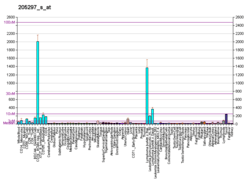CD79B
CD79b molecule, immunoglobulin-associated beta, also known as CD79B (Cluster of Differentiation 79B), is a human gene.[5]
It is associated with agammaglobulinemia-6.
The B lymphocyte antigen receptor is a multimeric complex that includes the antigen-specific component, surface immunoglobulin (Ig). Surface Ig non-covalently associates with two other proteins, Ig-alpha and Ig-beta, which are necessary for expression and function of the B-cell antigen receptor. This gene encodes the Ig-beta protein of the B-cell antigen component. Alternatively spliced transcript variants encoding different isoforms have been described.[5]
See also
References
Further reading
- Reth M (1992). "Antigen receptors on B lymphocytes". Annu. Rev. Immunol. 10: 97–121. doi:10.1146/annurev.iy.10.040192.000525. PMID 1591006.
- Müller B, Cooper L, Terhorst C (1992). "Cloning and sequencing of the cDNA encoding the human homologue of the murine immunoglobulin-associated protein B29". Eur. J. Immunol. 22 (6): 1621–5. doi:10.1002/eji.1830220641. PMID 1534761.
- Lankester AC, van Schijndel GM, Cordell JL, et al. (1994). "CD5 is associated with the human B cell antigen receptor complex". Eur. J. Immunol. 24 (4): 812–6. doi:10.1002/eji.1830240406. PMID 7512031.
- Vasile S, Coligan JE, Yoshida M, Seon BK (1994). "Isolation and chemical characterization of the human B29 and mb-1 proteins of the B cell antigen receptor complex". Mol. Immunol. 31 (6): 419–27. doi:10.1016/0161-5890(94)90061-2. PMID 7514267.
- Brown VK, Ogle EW, Burkhardt AL, et al. (1994). "Multiple components of the B cell antigen receptor complex associate with the protein tyrosine phosphatase, CD45". J. Biol. Chem. 269 (25): 17238–44. PMID 7516335.
- Rowley RB, Burkhardt AL, Chao HG, et al. (1995). "Syk protein-tyrosine kinase is regulated by tyrosine-phosphorylated Ig alpha/Ig beta immunoreceptor tyrosine activation motif binding and autophosphorylation". J. Biol. Chem. 270 (19): 11590–4. doi:10.1074/jbc.270.19.11590. PMID 7538118.
- Pani G, Kozlowski M, Cambier JC, et al. (1995). "Identification of the tyrosine phosphatase PTP1C as a B cell antigen receptor-associated protein involved in the regulation of B cell signaling". J. Exp. Med. 181 (6): 2077–84. doi:10.1084/jem.181.6.2077. PMC 2192043. PMID 7539038.
- Müller B, Cooper L, Terhorst C (1995). "Interplay between the human TCR/CD3 epsilon and the B-cell antigen receptor associated Ig-beta (B29)". Immunol. Lett. 44 (2–3): 97–103. doi:10.1016/0165-2478(94)00199-2. PMID 7541024.
- Saouaf SJ, Kut SA, Fargnoli J, et al. (1995). "Reconstitution of the B cell antigen receptor signaling components in COS cells". J. Biol. Chem. 270 (45): 27072–8. doi:10.1074/jbc.270.45.27072. PMID 7592958.
- Hashimoto S, Chiorazzi N, Gregersen PK (1995). "Alternative splicing of CD79a (Ig-alpha/mb-1) and CD79b (Ig-beta/B29) RNA transcripts in human B cells". Mol. Immunol. 32 (9): 651–9. doi:10.1016/0161-5890(95)00023-8. PMID 7643857.
- Hashimoto S, Chiorazzi N, Gregersen PK (1994). "The complete sequence of the human CD79b (Ig beta/B29) gene: identification of a conserved exon/intron organization, immunoglobulin-like regulatory regions, and allelic polymorphism". Immunogenetics. 40 (2): 145–9. doi:10.1007/BF00188178. PMID 7913081.
- Gold MR, Chiu R, Ingham RJ, et al. (1994). "Activation and serine phosphorylation of the p56lck protein tyrosine kinase in response to antigen receptor cross-linking in B lymphocytes". J. Immunol. 153 (6): 2369–80. PMID 8077654.
- Maruyama K, Sugano S (1994). "Oligo-capping: a simple method to replace the cap structure of eukaryotic mRNAs with oligoribonucleotides". Gene. 138 (1–2): 171–4. doi:10.1016/0378-1119(94)90802-8. PMID 8125298.
- Hashimoto S, Gregersen PK, Chiorazzi N (1993). "The human Ig-beta cDNA sequence, a homologue of murine B29, is identical in B cell and plasma cell lines producing all the human Ig isotypes". J. Immunol. 150 (2): 491–8. PMID 8419481.
- Wood WJ, Thompson AA, Korenberg J, et al. (1993). "Isolation and chromosomal mapping of the human immunoglobulin-associated B29 gene (IGB)". Genomics. 16 (1): 187–92. doi:10.1006/geno.1993.1157. PMID 8486355.
- Thompson AA, Wood WJ, Gilly MJ, et al. (1996). "The promoter and 5' flanking sequences controlling human B29 gene expression". Blood. 87 (2): 666–73. PMID 8555489.
- Astsaturov IA, Matutes E, Morilla R, et al. (1996). "Differential expression of B29 (CD79b) and mb-1 (CD79a) proteins in acute lymphoblastic leukaemia". Leukemia. 10 (5): 769–73. PMID 8656670.
- Koyama M, Nakamura T, Higashihara M, et al. (1996). "The novel variants of mb-1 and B29 transcripts generated by alternative mRNA splicing". Immunol. Lett. 47 (3): 151–6. doi:10.1016/0165-2478(95)00071-X. PMID 8747711.
- Carter RH, Doody GM, Bolen JB, Fearon DT (1997). "Membrane IgM-induced tyrosine phosphorylation of CD19 requires a CD19 domain that mediates association with components of the B cell antigen receptor complex". J. Immunol. 158 (7): 3062–9. PMID 9120258.
External links
- CD79B+protein,+human at the US National Library of Medicine Medical Subject Headings (MeSH)
- Human CD79B genome location and CD79B gene details page in the UCSC Genome Browser.
This article incorporates text from the United States National Library of Medicine, which is in the public domain.
This article is issued from
Wikipedia.
The text is licensed under Creative Commons - Attribution - Sharealike.
Additional terms may apply for the media files.




